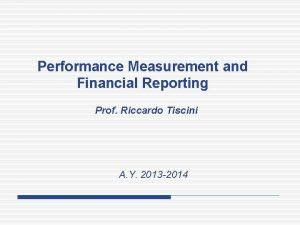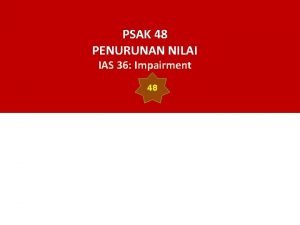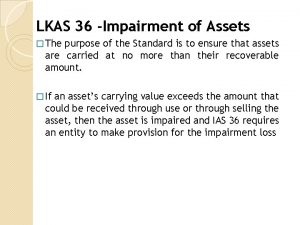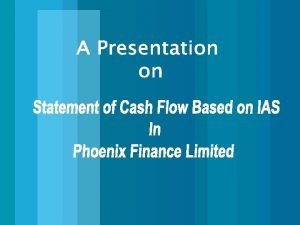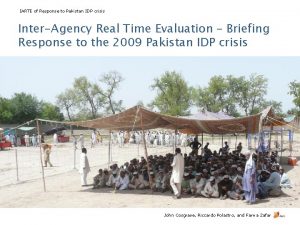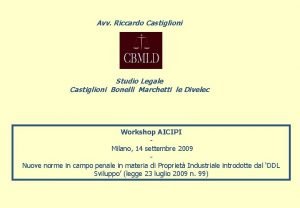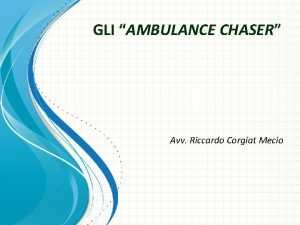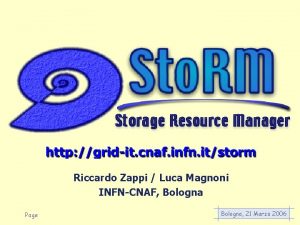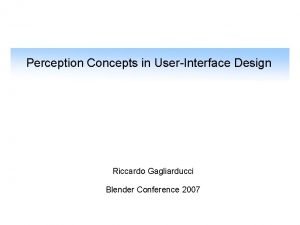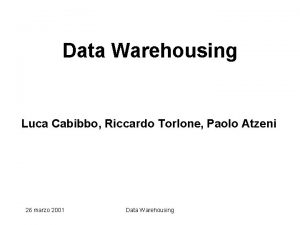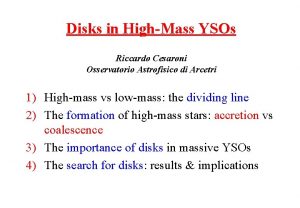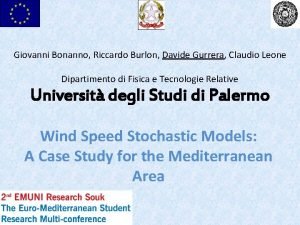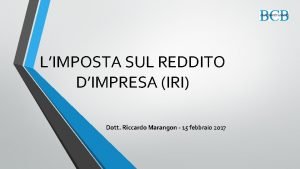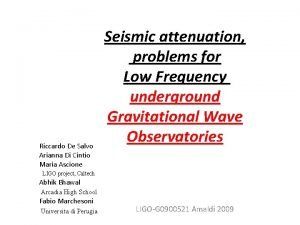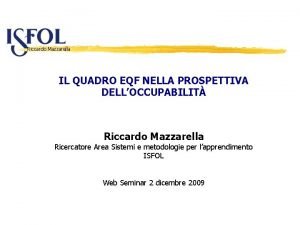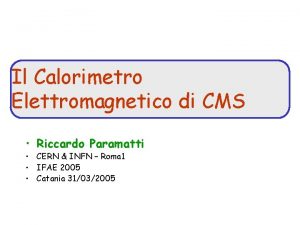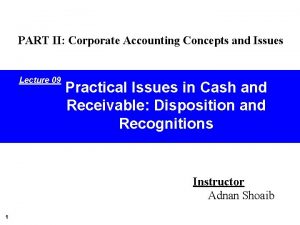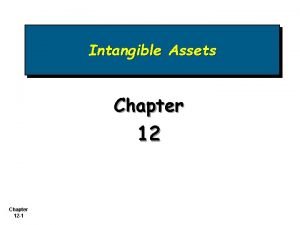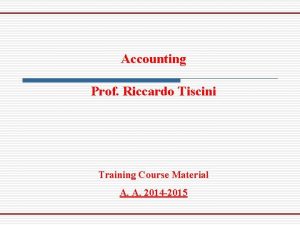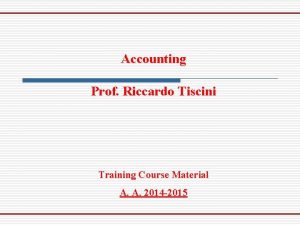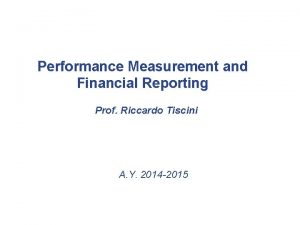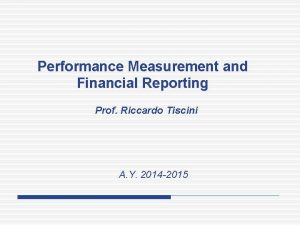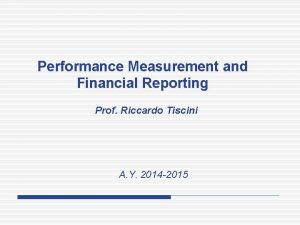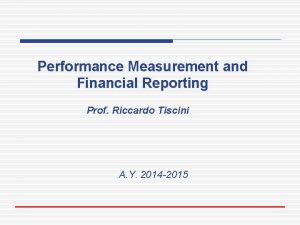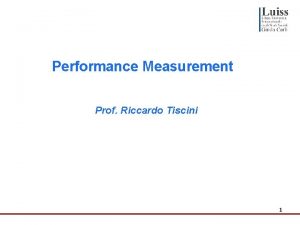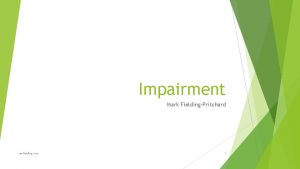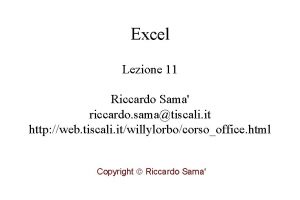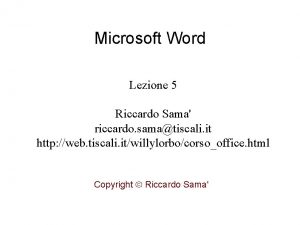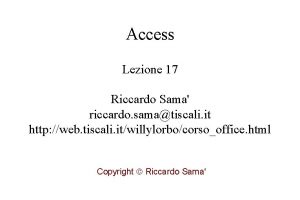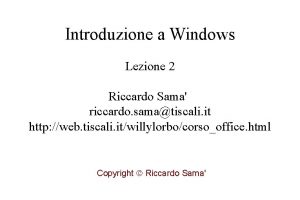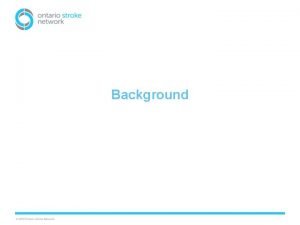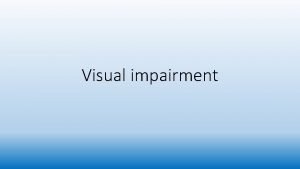Accounting Prof Riccardo Tiscini IAS 36 Impairment of



































- Slides: 35

Accounting Prof. Riccardo Tiscini

IAS 36: Impairment of Assets Accounting Course 2

IAS 36: Impairment of Assets IMPAIRMENT: IAS/IFRS An asset is impaired when its carrying amount (book value) exceeds its recoverable amount What is Recoverable Amount Accounting Course 3

IAS 36: Impairment of Assets Recoverable Amount: IAS/IFRS The higher of Value in use Fair value less costs to sell amount obtainable from the sale of an asset or cash-generating unit in an arm’s length transaction between knowledgeable, willing parties, less costs of disposal present value of the future cash flows (discounted at a certain rate) expected to be derived from an asset (from its use and from its final disposal) or cash generating unit Accounting Course 4

IAS 36: Impairment of Assets IMPAIRMENT: US GAAP An asset is impaired when its carrying amount (book value) exceeds the sum of the undiscounted cash flows The amount of the impairment is the excess of the book value of the asset over its fair value Accounting Course 5

IAS 36: Impairment of Assets IMPAIRMENT: US GAAP At the time the firm judges that an impairment loss has occurred, the firms reduces the book value of the asset to its current fair value Accounting Course 6

IAS 36: Impairment of Assets When making the assessment? At each reporting year if there is an indication that an asset may be impaired Independently of whethere is an indication of impairment, recoverable amount must be assed for Some assets Accounting Course 7

IAS 36: Impairment of Assets When making the assessment? At each reporting year the entity shall assess if there is an indication that an asset may be impaired If indications exist The entity must calculate the recoverable amount of the asset. Impairment Test If carrying amount of the asset exceeds this value, the entity must reduce the carrying amount to its recoverable amount and recognize an impairment loss in the income statement Accounting Course 8

IAS 36: Impairment of Assets Indications of impairment • – External sources • Market value declines; • Negative change in technology, markets, economy, or laws; • Increase in market interest rates; • Carrying amount of the net assets of the entity is more than its market capitalization. – Internal sources • Obsolescence or physical damage • Asset is part of a restructuring or held for disposal • Economic performance of an asset is worse than expected May be an indication that the asset’s useful life, depreciation method, or residual value need to be reviewed and adjusted Accounting Course 9

IAS 36: Impairment of Assets Mandatory Impairment test Independently of whethere is an indication of impairment, the recoverable amount of the following asset must be assessed each year: intangible assets with indefinite useful life; • Intangible assets not yet available for use; • Goodwill acquired in a business combination; • Not apply to • Inventory, Construction in progress, Employee benefit assets Accounting Course 10

IAS 36: Impairment of Assets Measuring Recoverable Amount It is not always necessary to determine both an asset’s fair value less costs to sell and its value in use. If either of these amounts exceeds the asset’s carrying amount, the asset is not impaired and it is not necessary to estimate the other amount Accounting Course 11

IAS 36: Impairment of Assets RECOVERABLE AMOUNT Shall be estimated for the individual asset. If it is no possible for individual asset, it shall be estimated for the cash-generating unit to which the asset belongs. Accounting Course 12

IAS 36: Impairment of Assets Recoverable amount of an individual asset It cannot be determined if: a) The asset’s value in use cannot be estimated close to its fair value less costs to sell and fair value less costs to sell cannot be determined b) The asset does not generate cash inflows largely independent of those from the other assets Recoverable amount of a Cash Generating Unit (CGU) Accounting Course 13

IAS 36: Impairment of Assets Cash-generating Unit (CGU) It is the smallest identifiable group of assets that generates cash inflows that are largely independent of the cash inflows from other assets of groups of assets a) Generate cash inflow from continuing use b) Are largely independent of the cash inflows from other assets or groups of assets Identification implies judgement Accounting Course 14

IAS 36: Impairment of Assets Cash-generating Unit It is not necessary to exchange cash flows with outsider companies. The output cab be also used internally. Nevertheless, for a CGU is not easy to estimate fair value less costs to sell because an active market must exist for the output produced by a CGU. So that it will be necessary to estimate a transfer price. Since it is difficult to estimate fair value for CGU, it will be necessary to calculate Value in use Accounting Course 15

IAS 36: Impairment of Assets Examples A mining entity owns a private railway to support its mining activities. The private railway could be sold only for scrap value and it does not generate cash inflows that are largely independent from the cash inflows of the other assets of the mine. It is not possible to estimate the recoverable amount of the private railway because its value in use cannot be determined and is probably different from scrap value. Therefore the entity estimates the recoverable amount of the cash-generating unit to which the private railway belongs, that is the mine as a whole Accounting Course 16

IAS 36: Impairment of Assets Examples A bus company provides services under contract with a municipality that requires minimum service on each of five separate routes. Assets devoted to each route and the cash flows from each route cannot be identified separately. One of the route operates at a significant loss. Because the entity does not have the option to curtail any one of bus route, the lowest level of identifiable cash inflows that are largely independent from the cash inflows of the other assets is the cash inflows generated by the five routes together. The CGU for each route is the bus company as a whole Accounting Course 17

IAS 36: Impairment of Assets Examples A company operates a mine in a country where legislation requires that the owner must restore the site on completion of its mining operations. The cost of restoration includes the replacement of the overburden which must be removed before mining operations commence…… following Accounting Course 18

IAS 36: Impairment of Assets Examples A provision for the costs to replace the overburden was recognized as soon as the overburden was removed. The amount provided was recognized as part of the cost of the mine and is being depreciated over the mine’s useful life. The carrying amount of the provision for restoration costs is Euro 500 which is equal to the present value of the restoration costs……. . following Accounting Course 19

IAS 36: Impairment of Assets Examples The entity is testing the mine for impairment. The CGU for the mine is the mine as a whole. The entity has received various offers to buy the mine at a price of around Euro 800. This price considers the fact that the buyer will assume the obligation to restore the overburden. Disposal costs for the mine are negligible. The value in use of the mine is approximately Euro 1, 200, excluding restoration costs. The carrying amount of the mine is Euro 1, 000. Accounting Course 20

IAS 36: Impairment of Assets Examples Solution: The CGU fair value less costs to sell is Euro 800. This amount considers restoration costs that have already been provided for. As a consequence, the value in use for the CGU is determined after consideration of the restoration costs and is estimated to be Euro 700 (1, 200 -500). The net carrying amount of the CGU is Euro 500 which is the carrying amount of the mine (Euro 1, 000) less the carrying amount of the provision for restoration costs (Euro 500). Therefore, the recoverable amount of the CGU exceeds its carrying amount. Accounting Course 21

IAS 36: Impairment of Assets Fair Value less costs to sell • • • The best evidence of this value is a price in a binding sale agreement in an arm’s length transaction (adjusted for the costs related to disposal of the asset); If there is no binding sale agreement but the asset is traded in an active market, it is the asset’s market price less the costs of disposal. The proper market price is usually the bid price. When bid price are not available, the price of the most recent transaction can be considered; If there is no binding sale agreement or active market, it is based on the best information available to reflect the amount the entity could get from the disposal of the asset (considering the recent transactions for similar assets within the same industry). Accounting Course 22

IAS 36: Impairment of Assets Value in use • Present value of the future cash flows discounted at a certain rate • Present value of the future cash flows undiscounted at a certain rate US GAAP IAS/IFRS Accounting Course 23

IAS 36: Impairment of Assets Value in use (IAS/IFRS) • Present value of the future cash flows discounted at a certain rate • Value in use estimation requires these two steps: • Estimating the cash inflows and outflows to be derived from continuing use of the asset and from its disposal; • Applying the appropriate discount rate to those future cash flows. Accounting Course 24

IAS 36: Impairment of Assets Value in use Elements to be considered in the calculation of an asset’s value in use: • an estimate of the future cash flows the entity expects to derive from the asset; • expectations about possible variations in the amount or timing of those future cash flows; • the time value of money, represented by the current market risk free rate of interest • other factors, such as illiquidity… NPV = CAH FLOWS / (1+i)^n Accounting Course 25

IAS 36: Impairment of Assets Value in use Estimates of future cash flows shall include: • projections of cash inflows from the continuing use of the asset; • projections of the cash outflows that are necessarily incurred to generate the cash inflows form continuing use of the asset; • net cash flows, if any, to be received (or paid) for the disposal of the asset at the end of its useful life. Accounting Course 26

IAS 36: Impairment of Assets Value in use Estimates of future cash flows shall NOT include: cash outflows or related cost savings (i. e. reductions in staff costs) or benefits that are expected to arise from a future restructuring to which an entity is not yet committed; • future cash outflows that will improve or enhance the asset’s performance or the related cash inflows that are expected to arise from such outflows. • Accounting Course 27

IAS 36: Impairment of Assets Measuring an Impairment loss If the recoverable amount of an asset is less than its carrying amount, the carrying amount shall be reduced to its recoverable amount That reduction is an impairment loss An impairment loss shall be recognised immediately in the income statement, unless the asset is carried at revalued amount in accordance with another standard (e. g. IAS 16). In this case any impairment loss shall be treated as a revaluation decrease Accounting Course 28

IAS 36: Impairment of Assets Measuring an Impairment loss An impairment loss on a revaluated asset is recognised in other comprehensive income (OCI) to the extent that the impairment loss does not exceed the amount in the revaluation surplus for the same asset. Such an impairment loss on a revaluated asset reduces the revaluation surplus for that asset. • • After the recognition of an impairment loss, the depreciation (amortization) charge for the asset shall be adjusted in future periods to allocate the asset’s revised carrying amount, less its residual value (if any) on a systematic basis over its remaining useful life. Accounting Course 29

IAS 36: Impairment of Assets CGU Impairment loss: an example A acquires B for 20. 000 at the end of 200 X. B works in 3 countries 200 X Country A Country B Country C Total Price 6. 000, 00 4. 000, 00 10. 000, 00 20. 000, 00 Fair value assets 4. 000, 00 3. 000, 00 7. 000, 00 14. 000, 00 Goodwill 2. 000, 00 1. 000, 00 3. 000, 00 6. 000, 00 At the end of 200 X and 200 X+1 the values in use for each CGU are lower than their carrying amounts Accounting Course 30

IAS 36: Impairment of Assets CGU Impairment loss: an example At the beginning of 200 X+2 A foreeses that the production will decrease by 50% It uses a straight line depreciation method with a useful life of 12 years The value in use of CGU A is 2. 720 200 X+2 A Cost Accumulated depreciation Carrying amount Impairment loss Carrying amount after impairment Goodwill 2. 000, 00 -2. 000, 00 Accounting Course Assets 4. 000, 00 -334, 00 3. 666, 00 -946, 00 2. 720, 00 Total 6. 000, 00 -334, 00 5. 666, 00 -2. 946, 00 2. 720, 00 31

IAS 36: Impairment of Assets Asset Impairment: Example 1 • Miller Company owns an apartment building that originally cost Euro 20 million and by the end of the current period has accumulated depreciation of Euro 5 million, with net carrying value of Euro 15 (20 -5) million. • Miller Company had originally expected to collect rentals of Euro 1, 67 million each year for 30 years before selling the building for Euro 8 million Accounting Course 32

IAS 36: Impairment of Assets Asset Impairment: Example 1 • Unanticipated placement of a new shopping center has caused Miller Company to reassess the future rentals. Miller Company expects the building to provide rentals for only 15 more years before Miller will sell it. Miller Company uses a discount rate of 8% per year in discounting expected rentals from the building Accounting Course 33

IAS 36: Impairment of Assets Asset Impairment: Example 1 • • Miller now expect to receive annual rentals of Euro 1. 35 million per year for 15 years and to sell the building for Euro 5 million after 15 years. The building’s fair value is Euro 12. 5 million today. Costs to sell are estimated at Euro 500, 000. Should the asset be impaired? Accounting Course 34

IAS 36: Impairment of Assets Asset Impairment: Example 2 • Now assume that Miller expects to receive annual rental of Euro 600, 000 per year for 15 years and to sell the building for Euro 3 million after 15 years. • The building’s fair value is Euro 5. 5 million today. Costs to sell are estimated at Euro 300, 000. Should the asset be impaired? Accounting Course 35
 Ias 2
Ias 2 Ias 17 finance lease criteria
Ias 17 finance lease criteria Riccardo tiscini
Riccardo tiscini Contoh kasus penurunan nilai aset
Contoh kasus penurunan nilai aset Lkas 36 impairment of assets
Lkas 36 impairment of assets International accounting standards ias
International accounting standards ias Riccardo polastro
Riccardo polastro Riccardo castiglioni
Riccardo castiglioni Riccardo sartori psicologo
Riccardo sartori psicologo Riccardo desalvo
Riccardo desalvo Anna rita simoni psichiatra
Anna rita simoni psichiatra Riccardo corgiat mecio
Riccardo corgiat mecio Riccardo magnoni
Riccardo magnoni Blender addon torrent
Blender addon torrent Riccardo asero
Riccardo asero Riccardo benussi
Riccardo benussi Riccardo callegari
Riccardo callegari Riccardo torlone
Riccardo torlone Mass8mo
Mass8mo Leone class
Leone class Fernando pavarotti riccardo pavarotti
Fernando pavarotti riccardo pavarotti Riccardo cioffi
Riccardo cioffi Riccardo faccini
Riccardo faccini Riccardo marangon
Riccardo marangon Riccardo ascione
Riccardo ascione Riccardo puglisi moglie
Riccardo puglisi moglie De lisa unica
De lisa unica Xen hvm config
Xen hvm config Riccardo dominici
Riccardo dominici Riccardo mazzarella
Riccardo mazzarella Calorimetro elettromagnetico
Calorimetro elettromagnetico Riccardo puglisi
Riccardo puglisi Impairment loss on receivables
Impairment loss on receivables Limbic system impairment quiz
Limbic system impairment quiz Objectives of intangible assets
Objectives of intangible assets Patofisiologi miopia
Patofisiologi miopia
